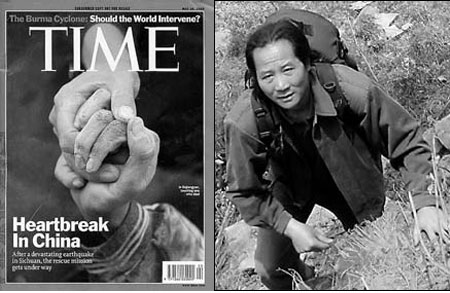Behind the lens of China's darkest hour
|
Left: Time magazine carries the photo taken by Zhu Jianguo. File photo Right: Zhu Jianguo is on his way to quake-hit areas. Courtesy of Zhu Jianguo |
CHENGDU: Ji Dongyang could not help but shed tears when he saw the cover spread of the May 26 Asian edition of Time magazine.
The front photograph, which showed a father and his dead son, crushed from the May 12 earthquake, deeply moved the middle-aged English teacher from Sichuan's Mianyang city.
"The photo which showed a hand of a father holding that of his deceased son - as if the father wanted to save the son from death - made me, the father of a 13-year-old daughter, heartbroken, just like the words on the photo 'Heartbreak in China'," he said.
Ji is not alone. The photograph has touched the hearts of many - including Zhu Jianguo, the photographer.
The chief photographer of the West China Metropolis Daily in Sichuan's capital Chengdu took the picture on May 13, a day after the 8.0-magnitude quake devastated the region.
Immediately after the earthquake struck on the afternoon of May 12, Zhu and his colleague Tu Jinjun headed for Wenchuan, the quake's epicenter. They failed to reach the county because landslides had blocked the road. Instead, they decided to gather news in hard-hit Dujiangyan, which is close to Chengdu.
When they arrived that evening, Zhu snapped endless rescue pictures of nearly 1,000 teachers and students, who had been buried under the collapsed Juyuan High school building. At midnight, he returned to the office in Chengdu to submit his photos to the editor.
The next day, Zhu returned to the school, staying all day. Despite rain, hundreds of soldiers searched through the debris for missing victims while students and relatives waited anxiously.
"Every 30 and 60 minutes, a survivor or body was pulled out of the debris. Relatives who had waited since the earthquake struck would rush to identify whether it was a face familiar to them," said Zhu.
"If a body was taken out on a stretcher, relatives did not want to have a look for fear it would be their loved one - but they also could not help identifying it. My ears were filled with inconsolable howls whenever a body was claimed."
Zhu said it was torture recording the miserable scenes with his camera. Still, he kept on in the trance of distorted bodies and despairing sobs.
Sometime in the morning, another body was pulled from the debris and again people ran to the stretcher. A middle-aged couple behind the crowd wobbled to the stretcher.
Once the newspaper covering the body's face was removed, the couple fell to the ground, speechless.
"I knew it must have been their son," said Zhu.
As the mother went to retrieve their son's belongings, the father took his child's limp hand - filled with mud and sand - and gripped it tightly, almost as though he was trying to take his son back from Azrael.
"With tears, I kept pressing the shutter," said Zhu .
Out of the 10,000-plus pictures Zhu took of the quake, he likes the photo he took of the father holding his son the most.
"The picture, which is named Hands and Hearts are Connected, not only reflects the love between the father and son, but also shows how the hands and hearts of the people nationwide are connected in the disaster relief. I hope it can give the living courage and let the dead rest in peace," he said.
"Many pictures, which depicted distorted bodies, are too bloody and too much of an eyesore. Even I do not want to keep them," said Zhu.
The photo was carried in the West China Metropolis Daily. Apart from Time magazine, it was widely circulated on the Internet, and also appeared on a huge poster promoting quake relief efforts organized by the Sichuan Daily Newspaper Group, Chengdu Disabled People's Federation and Chengdu Welfare Fund for the Handicapped.
"The picture whose composition is like that of the Schindler's List, is unique among a myriad of pictures about the earthquake because of its presentation of the beauty of human nature," commented one netizen.
At 51, Zhu is one of the oldest photographers covering the quake. He made the switch to photography in 1990 after 20 years of being an opera performer in Sichuan.
Despite the challenges presented by the May 12 disaster, Zhu has managed to reach all seriously affected cities and counties of the quake.
"Because of aftershocks, I could feel the roads shaking on my way to disaster-hit regions. Despite danger and hunger, I was determined to be closer to the disaster-ridden sites," said Zhu. "I was only afraid I was slow and missed any scene which would become history.
"My only hope was that my pictures could arouse more people's attention to care for the catastrophe of the Chinese nation and those people surviving it."
(China Daily 06/23/2008 page8)















